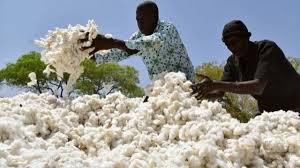Togo is making a bold attempt to revive its cotton sector, which has seen years of steady decline. The country is aiming to produce over 92,500 tons of seed cotton in the 2024–2025 farming season. This target, if achieved, would represent a 50% increase from last season’s output of 60,500 tons. However, the road to recovery is filled with obstacles such as climate change, pest outbreaks, falling youth participation, and competition from other crops.
Once a key pillar of Togo’s agriculture, cotton production has dropped by nearly half since 2017 when it peaked at 135,000 tons. Several seasons of poor yields and rising operational costs have pushed many farmers to abandon the crop. According to the National Federation of Cotton Producers (FNGPC), only 76,000 farmers were engaged in cotton farming this season, a sharp drop from 111,000 in the 2020–2021 season.
“The farming population is aging, young people are turning away. The entire cotton sector is at risk,” said Koussouwè Kourouféi, president of the FNGPC.
In an effort to turn things around, the government has launched this season’s planting earlier than usual to take advantage of expected good rainfall. Already, 118,000 hectares of farmland have been planted, the largest figure recorded in the past five years. But increasing land alone will not solve the problem. Authorities are now pushing a stronger recovery plan.
This includes training 120,000 farmers on improved methods, introducing regenerative farming practices, expanding irrigation systems, and promoting mechanization. The plan also involves public-private partnerships to provide financial and technical support.
To encourage farmers, the government has decided to keep the purchase price for seed cotton at CFA300 per kilogram, even though international prices have dropped by 14% this year. Additionally, farmers will continue to receive input subsidies to reduce the cost of production.
Despite these steps, many challenges remain. Weather-related risks like drought and flooding can destroy crops, and pest infestations still threaten yields even with awareness efforts. Moreover, many farmers are shifting to food crops like maize, soybeans, and yams, which are less risky and offer quicker financial returns.
“Cotton pays less, requires more work, and payments often arrive late. It is no longer motivating,” said a young farmer from Togo’s Central Region at a recent government-organized FOPAT meeting.
Soybeans are becoming especially attractive, thanks to growing global demand and the rise of local processing factories that now provide more reliable buyers.
Governance concerns also weigh on the sector. The New Cotton Company of Togo (NSCT), which was privatized and is now managed by Singaporean agribusiness giant Olam, has not provided clear information on its long-term plans. Some farmers and industry watchers are questioning the level of actual investment and the direction of the cotton strategy.
A major goal of the privatization was to build a complete cotton value chain—from farm to finished textile products—but that dream remains largely unrealized. Still, recent developments have brought back some hope. The country’s first textile factories have started operations this month at the Industrial Platform of Adétikopé (PIA). While still in early stages, the government believes these factories could eventually absorb more local cotton and increase national value addition.
But all these plans depend on whether the cotton sector can regain its attractiveness, especially among young people. The combination of hard labour, low profits, and unpredictable income is making cotton farming less appealing.
“The model needs to be rethought, or we risk reaching a dead end,” an agriculture ministry official said.
The coming season will test the strength of Togo’s recovery strategy. Success depends heavily on favorable weather, farmer motivation, and effective execution of reforms. The outcome will not only affect national cotton production but also the livelihoods of thousands of rural households that depend on the crop.
